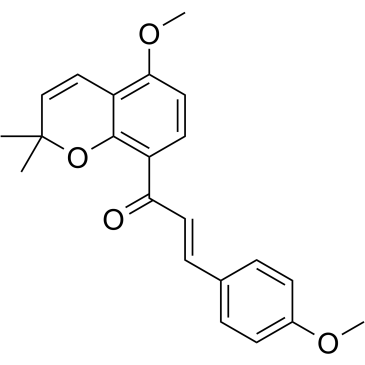Millepachine
Modify Date: 2025-08-25 18:58:20

Millepachine structure
|
Common Name | Millepachine | ||
|---|---|---|---|---|
| CAS Number | 1393922-01-4 | Molecular Weight | 350.414 | |
| Density | 1.139±0.06 g/cm3(Predicted) | Boiling Point | 528.2±50.0 °C(Predicted) | |
| Molecular Formula | C22H22O4 | Melting Point | N/A | |
| MSDS | N/A | Flash Point | N/A | |
Use of MillepachineMillepachine is a bioactive natural chalcone from Chinese herbal medicine Millettia pachycarpa Benth, exhibits strong antitumor effects against numerous human cancer cells both in vitro and in vivo[1]. |
| Name | millepachine |
|---|
| Description | Millepachine is a bioactive natural chalcone from Chinese herbal medicine Millettia pachycarpa Benth, exhibits strong antitumor effects against numerous human cancer cells both in vitro and in vivo[1]. |
|---|---|
| Related Catalog | |
| In Vitro | Millepachine (1.25-20 μM; 48 h) remarkably inhibits the proliferation of cisplatin-resistant A2780CP cells[1]. Millepachine (2-8 μM; 24 or 48 h) induces G2/M arrest and apoptosis cisplatin-sensitive A2780S and cisplatin-resistant A2780CP cells[1]. Millepachine (2-8 μM; 24 h) decreases topoisomerase II levels in A2780S and A2780CP cells[1]. Millepachine (2-8 μM; 24 h) inhibits ATP-binding cassette transporter activity in A2780CP cells[1]. Cell Proliferation Assay[1] Cell Line: A2780CP cells Concentration: 0, 1.25, 2.5, 5, 10, 20 μM Incubation Time: 48 hours Result: Inhibited the cells proliferation with an IC50 of 4 μM. Cell Cycle Analysis[1] Cell Line: A2780S and A2780CP cells Concentration: 2, 4, 8 μM Incubation Time: 24 or 48 hours Result: Induced significant G2/M arrest both in both cells. The percentage of cells in the G2/M fraction increased from 15.99% in vehicle cells to 24.93%, 60.67%, and 77.31% at dose of 2, 4, and 8 μM in A2780S cells, respectively. Apoptosis Analysis[1] Cell Line: A2780S and A2780CP cells Concentration: 2, 4, 8 μM Incubation Time: 24 or 48 hours Result: The percentage of apoptotic cells increased from 1.49% in vehicle cells to 10.98%, 20.60%, and 39.43% at dose of 2, 4, and 8 μM in A2780S cells, respectively. The percentage of apoptotic cells increased from 0.87% to 10.97%, 25.28%, and 37.59% in A2780CP cells, respectively. Western Blot Analysis[1] Cell Line: A2780S and A2780CP cells Concentration: 0, 2, 4, 8 μM Incubation Time: 24 hours Result: Decreased the levels of topoisomerase II (TOPO II) in both cells. |
| In Vivo | Millepachine (20 mg/kg; i.v. every two days for 14 day) inhibits tumor growth in mice[1]. Millepachine (20 mg/kg; i.v. every two days for 14 day) does not induce acquired drug resistance in an excised A2780S xenograft model[1]. Animal Model: Female BALB/c nude mice (6 weeks) are injected A2780S or A2780CP cells[1] Dosage: 20 mg/kg Administration: I.v. every two days for 2-14 days Result: Reduced tumor volume and tumor weight with the inhibitory rate of 73.21% and 65.58% in A2780S (after seven times injection) and A2780CP (after six times injection) xenograft model, respectively. With low toxicity in vivo. |
| References |
| Density | 1.139±0.06 g/cm3(Predicted) |
|---|---|
| Boiling Point | 528.2±50.0 °C(Predicted) |
| Molecular Formula | C22H22O4 |
| Molecular Weight | 350.414 |
| InChIKey | GZUOKKIDYHPTAZ-YRNVUSSQSA-N |
| SMILES | COc1ccc(C=CC(=O)c2ccc(OC)c3c2OC(C)(C)C=C3)cc1 |
| Hazard Codes | Xn |
|---|